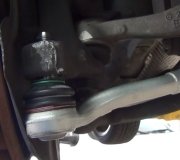I suspect the issue here is poor communication on the mechanic's part, and possibly some things were lost in translation if a service writer was involved. Being hard to turn the steering wheel can be caused by binding in the steering gear, meaning metal parts are physically bent and are rubbing on each other. A totally different cause is loss of power steering assist, similar to when you try to turn the steering wheel when the engine is not running. Some mechanics call that "binding", but they mean it turns with great difficulty. This equates to saying there's something wrong with the floor lamp in your house when the actual cause of the problem is there is a city-wide power outage.
You have described two different symptoms. It is possible they can be related, but typically they are not. I will describe both of the things to look for.
The clunking while turning is usually caused by a binding upper strut mount. That part holds up all of the car's weight on that corner, but it has a roller bearing assembly to make the wheel easier to turn left and right. Dirt and rust can get in the bearings, or they can just fall apart. To identify this as the cause of the clunking, reach over the top of a front tire and wrap your fingertips lightly over part of the coil spring. Have a helper slowly turn the steering wheel left and right. You should feel the spring rotate smoothly with the tire. If the bearing is binding, you will feel the spring wind up and build tension, then suddenly pop free and rotate. That popping free is the clunking you are hearing. It is not a safety concern, but if it gets bad enough, it can make for a tiring car to drive. You will not hear this noise while driving because road vibration helps the wheels to turn.
The loss of power steering assist does not involve noise, except for the times when this is caused by a failed power steering pump. When the pump fails, there is no power assist when steering in either direction. That is the important clue.
When you have hard steering in only one direction, it is important to understand you do have power assist in the other direction. That is proof the power steering pump is working. Loss of power assist only one way is what I referred to in my original reply. This has been a real sore point for owners of GM front-wheel-drive cars. The cause is due to internal fluid leakage inside the control valve in the rack and pinion steering gear. GM's solution was to replace the valve assembly in hopes it would hold up until the car made it out of the 50,000 mile warranty.
The actual cause was not the valve assembly. It has Teflon sealing rings on it. Those rings cut grooves into the soft aluminum housing, and those grooves are what allowed the internal leakage to occur. The proper repair was developed by the aftermarket re-builders. They bore out the cylinder with the grooves, then press in a stainless steel liner that withstands that wear. The problem is the car owner has to pay for that repair, which is much more expensive than what GM did.
That type of wear can occur on any brand of car that uses a rack and pinion steering gear, but it usually takes 200,000 to 300,000 miles before that happens. All rebuilt steering gears from the national manufacturers get those stainless steel liners, and those do not develop this problem. The clue to this is the loss of power assist affects turning in only one direction at first. It will clear up after a minute to as much as fifteen minutes, when the power steering fluid warms up. A few weeks to a few months later you will also lose power assist when turning in the other direction.
This is not a safety concern in that you still can turn the steering wheel, but without the power assist. What makes the car hard to control is not knowing exactly when the wheel will turn easily or with difficulty. You can end up tugging too hard on the wheel and turning too far. This type of problem never causes the steering system to lock up solidly, as a few people still mistakenly think.
Monday, April 3rd, 2017 AT 6:03 PM


